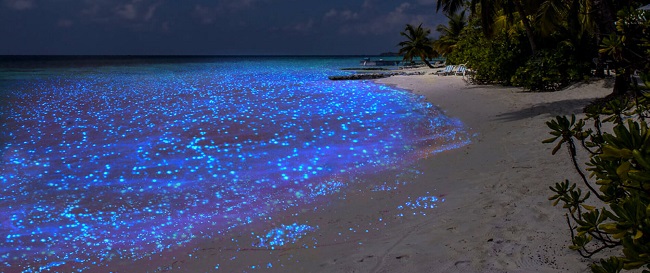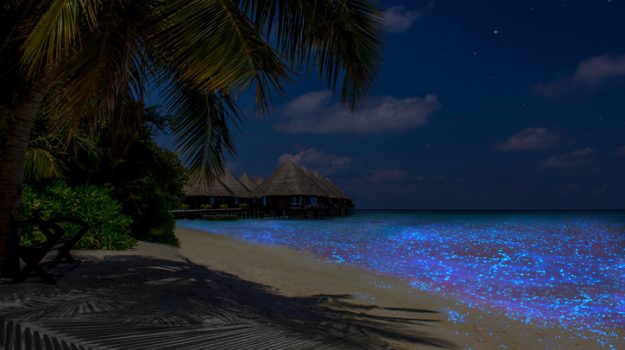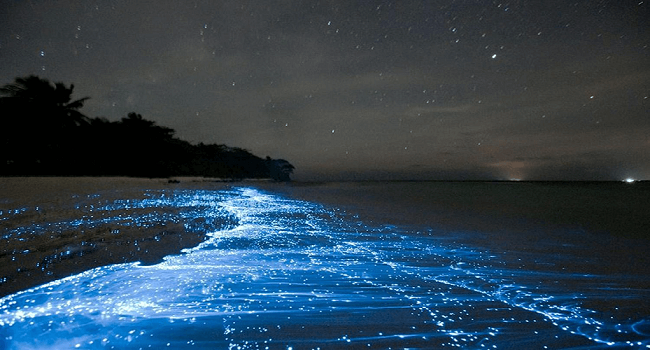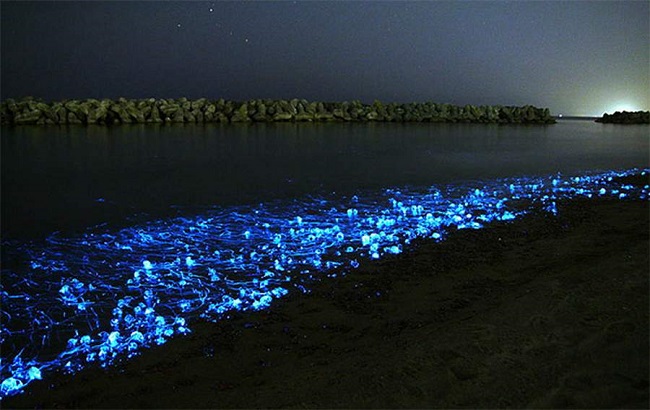L’Oceano brilla di luci blu e bianche quando migliaia di bioluminescenti calamari lucciola, dalle onde del mare arrivano in superficie in Primavera durante la stagione di Hotaru Ika, nella baia di Toyama in Giappone.
I calamari lucciola (Watasenia scintillans) si trovano nell’Oceano Pacifico occidentale a profondità da 200 a 600 metri, questi calamari emettono la luce attraverso dei fotofori sul loro corpo, amalgamandola alla superficie del mare.
I calamari lucciola si nutrono di pesce, granchi e crostacei planctonici, trascorrono la giornata nelle profondità del mare, ritornando in superficie di notte, in riva al mare quando si possono vedere i calamari coordinare le loro intense luci azzurre e blu, facendole lampeggiare insieme o alternandole in vari modelli, e creando così un meraviglioso spettacolo di scintillii sulla superficie del mare.
I calamari usano ogni modello per vari motivi, per comunicare, nutrirsi, mischiarsi con la luce e potersi così proteggere dai predatori o per attirare un partner nella stagione degli accoppiamenti. Molti turisti arrivano nella regione per ammirare la bellissima manifestazione di un Oceano che scintilla di luci quando le correnti nella baia di Toyama portano i calamari lucciola in riva al mare.
Un altro bellissimo spettacolo della Natura si può ammirare nelle calde acque delle isole Maldive sulla spiaggia di Vaadhoo, quando il mare brilla in una miriade di ostracodi crostacei. Di notte c’è un aumento di bioluminescente fitoplancton prodotto dai piccoli organismi che brillano come lucciole spinti dalle correnti sulle onde del mare. Gli organismi bioluminescenti illuminano anche le traiettorie dei delfini, attaccandosi come polvere magica sulla pelle dei simpatici delfini. 
“Le stelle nella sabbia” sono alghe e piccoli organismi chiamati plancton spinti dalle correnti oceaniche sulle spiagge sabbiose delle Hawaii. Questi organismi chiamati Noctiluca scintillans, di giorno stanno al sole tra la sabbia, di notte brillano come stelle sulla spiaggia. Nelle acque oceaniche ci sono varie specie bioluminescenti: coralli, calamari, meduse, plancton, pesci. Di recente sono state scoperte anche alcune specie di squali bioluminescenti come ad esempio lo squalo zigrino (Dalatias licha) di due metri di lunghezza. Sono squali che abitano nelle profondità dell’oceano tra i 200 e i 1000 metri, emettono una luce blu-verde attraverso dei fotofori sulla loro pelle.

La bioluminescenza è diversa dalla fluorescenza che avviene quando organismi assorbono luce da una fonte esterna e la emettono in un colore diverso come la fluorescente tartaruga di mare embricata, mentre gli organismi bioluminescenti producono la loro propria luce attraverso una reazione chimica.
Quando l’ossigeno e le sostanze biologiche, luciferina e luciferasi si trovano insieme, producono energia che viene rilasciata come luce, che può essere di vari colori dipende dalle specie bioluminescenti.
Mentre le specie acquatiche spesso brillano di blu, o verde-blu, poiché questo colore si adatta meglio nell’oceano, le lucciole sulla terra brillano di colore arancione, giallo, rosso. Un altro grande spettacolo di bioluminescenza si può vedere sulla spiaggia di Mosquito Bay, Porto Rico nelle isole dei Caraibi, nella magica atmosfera della notte, mentre una leggera brezza attraversa il profondo suono dell’oceano, e il mare brilla di scintillii bianchi e blu come le stelle.
SCINTILLANT OCEANS
The Ocean shines of brilliant blue and white lights when thousands of bioluminescent firefly squids come together to the surface by sea waves, on Spring at Toyama Bay in Japan. The firefly squids (Watasenia scintillans) are found in the Western Pacific Ocean at depths of 200 to 600 meters, these squids emit light through photophores on their body, matching their brightness and color to the sea surface above.
Firefly squids eat fish, crabs, crustaceans, they spend the day at the sea bottom, returning to the surface along the shore at night, when we can see thousands of squids coordinate their deep blue lights to flash together or alternate in different patterns, creating a marvelous show of blue, white glims, on the surface of seawater.
Squids use each pattern for different purposes, to communicate, to feed, to blend in with the light, so that they can protect themselves from predators or to seduce a partner, during the mating season, Many tourists arrive at the region to admire the beautiful show of lights on the Ocean when the currents in the bay bring the firefly squids close to the seashore. Another beautiful show of Nature is in the warm waters of Maldives Islands at Vaadhoo beach, when the sea sparkles with a myriad of ostracod crustaceans. At night there is an increase in bioluminescent phytoplankton produced by tiny organisms which glow like fireflies jostled by currents on sea waves. The bioluminescent organisms also bright the dolphins’ routes and stick to the dolphins’ skin like fairy dust.
“Stars in the sand” when the sand sparkles at Hawaii’s beaches, it’s given by algae and tiny organisms called plankton, which are washed up on the sand by Ocean currents. These organisms are called Noctiluca scintillans, they sunbathe on the sand by day and twinkle in the sand beach like stars at night.
In the oceanic waters, there are many bioluminescent species: corals, squids, jellyfish, plankton, fishes. Recently some bioluminescent deep-sea sharks have been discovered, as the Kitefin shark (Dalatias licha) two meters in length. These sharks live in the ocean depths between 200 and 1000 meters, they emit a blue-green light from their photocytes on their skin.
Bioluminescence is different from fluorescence which occurs when organisms absorb light from an external source and reemit it in a different color like the hawksbill sea turtle a fluorescent turtle species, while bioluminescent organisms produce their own light through a chemical reaction.
When oxygen and the biological substances luciferin and luciferase come together, energy is produced and is released as light which can be in various colors, depending on the bioluminescent species.
While bioluminescent aquatic species often glow blue or blue-green, because this color can matches best in the ocean, fluorescent fireflies on land, glow orange, yellow, red. Another great show of bioluminescence can be seen on the beach of Mosquito Bay, Puerto Rico in the Caribbean islands, in the magic atmosphere of the night while a soft breeze goes through the deep sound of the ocean, the sea glitters of white blue sparkles like the stars.







